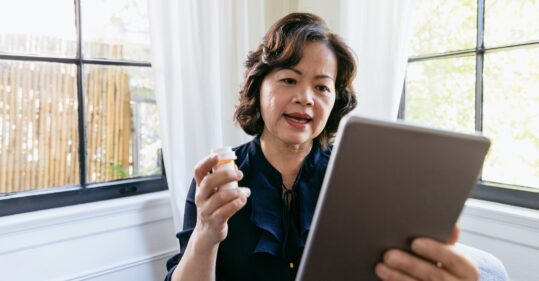How to undertake video consultations in primary care

The need to see patients remotely is growing as the Covid-19 outbreak escalates. Many practices are looking for remote solutions for both doctors and practice nurses.
In this guide Professor Trisha Greenhalgh from the University of Oxford, along with input from Clare Morrison of the Scottish Government’s technology enabled care programme and Professor Gerald Koh Choon Huat from the National University of Singapore lay out some tips for seeing patients via video.
This guide covers the following questions:
Related Article: ‘Patients not prisoners’: Palliative care nursing behind bars
- When are video consultations appropriate in primary care?
- How can users conduct a high-quality video consultation in primary care?
It also includes a preliminary template for a video consultation in primary care with a patient who may have Covid-19 (further below).
When are video consultations appropriate in primary care?
Covid-related consultations: video may be appropriate when:
- A healthcare worker is self-isolating (or to protect the clinical workforce)
- The patient is a known Covid-19 case or is self-isolating (eg a contact of a known case)
- The patient has symptoms that could be due to Covid-19
- The patient is well but anxious and requires additional reassurance
- The patient is in a care home with staff on hand to support a video consultation
- There is a need for remote support to meet increased demand in a particular locality (eg during a local outbreak when staff are off sick)
Non-Covid-related consultations: video may be appropriate for:
- Routine chronic disease check-ups, especially if the patient is stable and has monitoring devices at home
- Administrative reasons eg repeat medication
- Counselling and similar services
- Duty doctor/nurse triage when a telephone call is insufficient
- Any condition in which the trade-off between attending in person and staying at home favours the latter (eg in some frail older patients with multi-morbidity or in terminally ill patients, the advantages of video may outweigh its limitations)
On the basis of current evidence, we suggest that video should not generally be used for:
Related Article: NHSE confirms dates and eligibility for autumn Covid and flu jabs
- Co-morbidities affecting the patient’s ability to use the technology (eg confusion), or serious anxieties about the technology (unless relatives are on hand to help)
- Some deaf and hard-of-hearing patients may find video difficult, but if they can lip-read and/or use the chat function, video may be better than telephone
How to conduct a high-quality video consultation in primary care.
Before the consultation
- Confirm that (as far as you can assess in advance) a video consultation is clinically appropriate for this patient at this time
- Use a private, well-lit room and ask patient to do the same
- Take the patient’s phone number in case the video link fails
- Ensure you have access to the patient’s clinical record (ideally, have it available on a second screen)
- On the day, check that the technology is working
Starting the consultation
- Initiate the consultation by calling or inviting the patient
- Say something eg “can you hear me?” “can you see me?” to prompt patient to optimise the technical set-up
- Take and record verbal consent for a video consultation
- Introduce everyone in the room (even those off-camera), and ask patient to do the same or confirm that they are alone
- Reassure the patient that the consultation is likely to be very similar to a standard one, and that the call is confidential / secure
Having a video consultation
Related Article: ‘Concerning acceleration’ in drug-resistant gonorrhoea ahead of vaccine programme
- Video communication works the same as face to face, but it may feel less fluent and there may be glitches (eg blurry picture)
- You don’t need to look at the camera to demonstrate that you are engaged. Looking at the screen is fine
- Inform the patient when you are otherwise occupied (eg taking notes or reading something on another screen
- Make written records as you would in a standard consultation
- Be aware that video communication is a bit harder for the patient
Closing the consultation
- Be particularly careful to summarise key points, since it’s possible something could have been missed due to technical interference
- Ask the patient if they need anything clarified
- Confirm (and record) if the patient is happy to use video again
- To end, tell the patient you’re going to close the call now, and say goodbye (before actually closing the connection).

See how our symptom tool can help you make better sense of patient presentations
Click here to search a symptom


The need to see patients remotely is growing as the Covid-19 outbreak escalates. Many practices are looking for remote solutions for both doctors and practice nurses.



